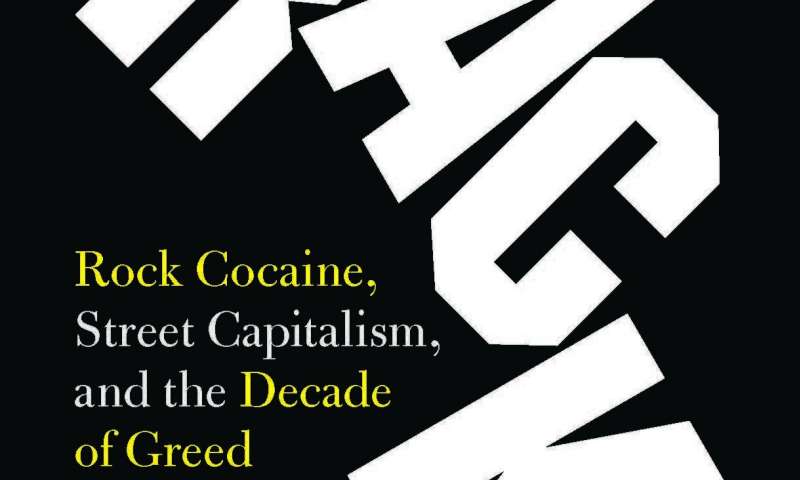
When David Farber lived in Philadelphia, he met a crack dealer who sold the drug to a mostly homeless clientele outside the professor’s apartment.
“I literally talked to him 20 times when he was selling crack 30 feet from where I was working,” said Farber, the Roy A. Roberts Distinguished Professor in the Department of History at the University of Kansas.
“But I didn’t really understand his operation. Like, where’d he get the crack? And why was he selling only to these down-and-out people?”
Ten years later, Farber endeavors to make sense of the history, economics and lifestyle that accompanies this vilified drug in his new book, Crack: Rock Cocaine, Street Capitalism, and the Decade of Greed (Cambridge University Press).
“Every drug is unique,” Farber said. “It’s less about the pharmacology of the substance than it’s about how, why, where and when people take the drug. I tried to write about the crack years of the ’80s and ’90s as more than just ‘this new substance that comes out and destroys lives,” but as a drug that exists for very specific reasons, for very specific people at a specific time.”
A commodity made from combining cocaine, baking powder and water, then cooking it down to a hard pellet known as a “rock,” crack offered a low-cost option for a fleeting, powerful high.
In the book, Farber writes, “As a commodity, crack was the perfect narcotic for people who lived dollar to dollar but were desperate to escape, as often as possible, from the drudgery, pain, boredom or sadness of their lives. Lots of drug users smoked crack; a majority were white. But crack’s core customers were disproportionately low-income African Americans who were already disconnected from the labor market.”
The author says one of the enduring misunderstandings about the drug is that it’s uniquely harmful.
“It can be addictive, dangerous and destructive, but it’s not physiologically addictive the way opioids are. Plenty of people smoke crack once, five, a dozen times and go about their lives,” he said.
Farber spent years researching the book. Extracting the official version of the story through the eyes of legislators and law enforcement was simple. The other side proved problematic because of the inherent illegality of the subject matter.
“I really saw this book as a story of a business,” he said. “Here are these guys who are living in places where they have few economic opportunities. Basically, out of nothing, they create what is essentially a billion-dollar industry. They’re the Steve Jobs of the deviant world.”
In addition to poring through numerous court cases to understand the day-to-day strategies and challenges of distributing the drug, Farber turned to several unexpected sources. First, he was surprised how many crack dealers confess their stories on YouTube. Second, he discovered a whole semi-underground industry devoted to documenting criminal exploits.
“There are so many books and magazines for convicts and ex-offenders, often written by convicts and ex-offenders—some of which you can find online. You can go into certain neighborhoods, and they’re sold at corner stores,” he said.
He also spoke to a quartet of crack dealers to gain their personal insights into the trade.
“None of them felt dangerous. Some of them were interesting. All of them were smart, which I don’t think is the rule,” he said. “There’s a Robin Hood or social bandit quality to all this. So in some quarters of some communities, these guys were heroes. And many like to tell their stories.”
Also intertwined with the criminality and economics of crack was the political climate in which the narcotic emerged. The ’80s. The Decade of Greed. Reaganomics.
“Is it Ronald Reagan’s fault?” Farber asked.
“There’s a kind of culture within the hip-hop community that sees this as being straight-up conspiratorial. “The CIA and Reagan conspired to put crack in poor black communities.” I think that’s not true. And I tried to prove that’s not true. It was not the CIA that created crack in order to somehow destroy black lives. But I do argue that you see in the 1980s a tremendous disinvestment by the federal government in racial justice issues and poor people’s concerns in general.”
He says it’s impossible to approach this topic without acknowledging the role racism played.
“This is one more story about the ways in which racial injustice has structured our society. And it puts some very creative, very capable and very thoughtful young men in a position where the best they thought they could do for themselves was to get involved in a murderous business that helped destroy their own community,” he said.
Farber realizes most attempts to paint those who profited from crack as anything but “monstrous” are met with fierce resistance. In the Sept. 25 issue of The Washington Post, Farber contributed an article titled “How drug-related violence complicates criminal justice reform” about the ways in which Americans wrestle with showing mercy to drug dealers.
“A couple individuals told me I’m a limousine liberal, and I don’t understand what it’s like to deal with criminals,” Farber says of commenters reacting to his piece on the newspaper’s site.
“I’m an academic. I’m not an activist. The University of Kansas doesn’t pay me to write polemics. My job is to write empirically sound, carefully reasoned books and articles. And that’s what “Crack’ is supposed to be. This is a scholar’s take on a really hard time in America.”
Farber is the author of more than a dozen books, including “The Rise and Fall of Modern American Conservatism,” “The Age of Great Dreams: America in the 1960s” and “Taken Hostage: The Iran Hostage Crisis and America’s First Encounter with Radical Islam.” His work typically focuses on political culture, social change movements and capitalism in 20th-century U.S. history.
Source: Read Full Article
